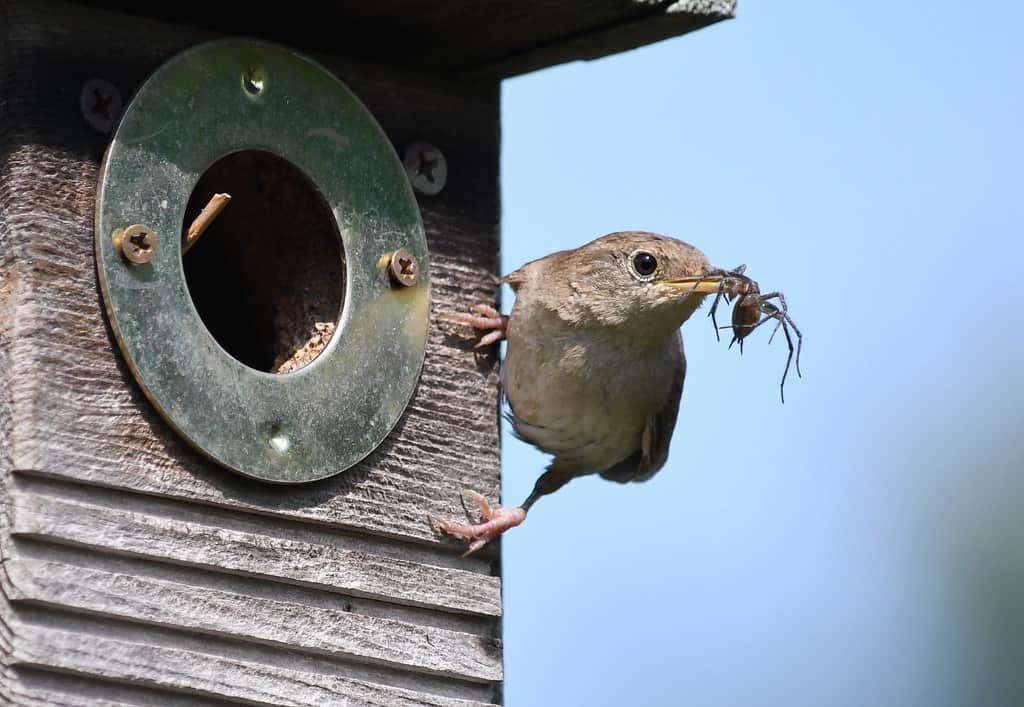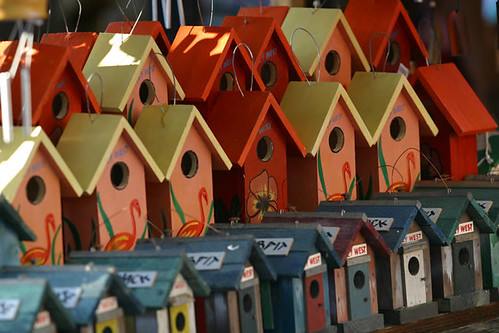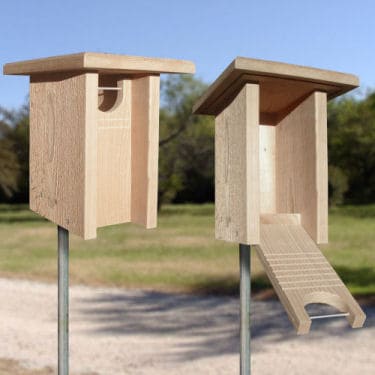
Responsible bluebird enthusiasts are usually pretty welcoming to any native cavity-nesting bird that wants to use their bluebird house. Tree swallows, chickadees, and nuthatches, for example, are all native birds that use bluebird nest boxes. However, that welcoming spirit that we show to native birds doesn’t always extent to house wrens.
House wrens are territorial, aggressive birds, and they often destroy bluebird eggs when the two species are nesting in close proximity. Because of this, even though house wrens are a native species to North America, many people actively discourage house wrens from using bluebird houses.
You might also be looking for ways to deal with a house wren problem. So here are five methods to discourage house wrens from using your bluebird houses:
- Mount bluebird houses at least 50 feet away from heavily wooded areas
- Take down or modify any ornamental bird houses in your yard
- Keep wrens busy by removing their “dummy nests”
- Use wren guards on active bluebird houses
- Avoid using bluebird houses with larger entrance holes or slot entrances
Best Nest Box: My all-time favorite nest box for bluebirds is the Nature’s Way model CWH4. It has so many features that I love. Get one of these bird houses on Amazon here.
1. Mount Bluebird Houses At Least 50 Feet Away From Heavily-wooded Areas

The best way to discourage house wrens from using your bluebird houses is to mount them away from a wren’s natural habitat. So, what kind of habitat is attractive to wrens? House wrens love wooded areas, especially ones that have brushy spaces on the ground where they can seek cover. Because of this, the North American Bluebird Society suggests mounting bluebird houses “50-200 feet away from brushy and heavily-wooded areas” to avoid attracting house wrens. (source)
Mount your nest box in an open area, preferably with small trees or a fence-line nearby. This will set you up for success in attracting bluebirds. Bluebirds love to hunt insects in the grass from low perches like small trees, low-hanging branches, and fence-lines, so having some of these nearby would be ideal.
Choosing a spot like this, especially when it’s away from brushy wooded areas, is the first best thing you can do to discourage competition with house wrens for your bluebird houses. This could be considered a “proactive” method of discouraging house wrens.
Next, let’s look at another proactive method of deterring house wrens.
2. Take Down or Modify Ornamental Bird Houses In Your Yard

Ornamental bird houses are a popular addition to many yards and gardens. It’s common for these nest boxes to have perches and triangular rooftops. The design of these bird houses makes them the perfect spot for wrens to nest, therefor, having these nest boxes available in your yard can increase your local house wren population.
Since these ornamental bird houses attract house wrens, and can increase competition between wrens and bluebirds, it’s recommended to take down or modify these bird houses so that wrens can’t use them.
Why ornamental bird houses attract house wrens
Most decorative nest boxes have entrance holes that are too small for bluebirds (read the article I wrote on correct entrance hole sizes here), but they’re usually the perfect size for house wrens. Since house wrens are much smaller than bluebirds, they can deal with a smaller entrance hole and nest box. Because larger birds can’t fit inside of most decorative bird houses, wrens will often times have free reign over them, which is very attractive to them. Even better if the bird house has a perch! House wrens love perches.
What to do with ornamental bird houses
Once house wrens claim a nest box, they will also become very territorial of other nest boxes in the area. So, if you leave up a few ornamental bird houses around your yard and wrens claim them, they could start acting violently toward your beloved bluebirds nesting in the area, destroying their eggs and even killing their nestlings. So, overall, it’s just better to get rid of these decorative bird houses all together.
If you love the look of your decorative bird houses and can’t bear to part with them, there is something you can do to prevent their use by house wrens. Modify the bird houses by (1) plugging the entrance hole or (2) removing the floor board. (You could even build a bird house yourself and paint on a black entrance hole instead of cutting in a real hole.) Any of these options will render the nest box useless to house wrens and they’ll look for a home elsewhere – hopefully in someone else’s yard!
Note: Do you have a problem with House Sparrows using your bluebird nest box? I wrote another article called How to Keep House Sparrows Out of Bluebird Houses that I encourage you to read!
Next, let’s consider a “reactive” approach to keep wrens out of bluebird houses.
3. Keep Wrens Busy by Removing Their “Dummy Nests”
If you have multiple bluebird houses on your property, it’s possible that wrens will leave your bluebirds alone the majority of the time. This is what I usually have seen in my experience. But you still might do well to discourage further nesting by house wrens. So, if house wrens are currently leaving your bluebirds in peace, but you still don’t want them nesting nearby, keep the wrens busy by continually removing their dummy nests.
What does a house wren “dummy nest” look like?
Unlike bluebirds, the male house wren is the one who constructs the nest. In his quest to attract a mate, he will typically build multiple “dummy nests” in a number of different bird houses and natural cavities. He likely builds these nests to offer the female multiple options for a nesting site. He probably also does it to rid the area of available nest boxes to protect his territory.

Photo by Dendroica cerulea is licensed under CC BY-NC-SA 2.0
To build a dummy nest, the male wren will fill a bird house with loose twigs. It will be similar to an active nest, but won’t quite look complete. Then, when the female wren decides which nesting site she prefers, the male will convert that pile of sticks into an active nest, leaving the rest of the “dummy nests” unused.
So, if one of your bluebird houses is full of an unorganized bunch of sticks and twigs, this is likely a house wren “dummy nest.” You can especially tell if it’s a dummy nest by checking for a nest cup. If the nest doesn’t have a nest cup in the back, lined with soft materials, like hair and feathers, then it’s most likely a dummy nest. See the photo above for an example of a dummy nest.
What does an active house wren nest look like?

Photo by annahesser is licensed under CC BY-NC-ND 2.0
If the nest that you find has no nest cup, the birds don’t plan on using the nest for laying eggs, so you can consider this a “dummy nest” and remove it. Since the Migratory Bird Treaty Act only protects active house wren nests, you can legally remove these dummy nests in the US (source). But do not remove an active wren nest. They are protected under law.
How to properly remove a house wren “dummy nest”
When you find a dummy nest that you want to remove, take the sticks out of the nest box and place them into a bucket or bag. It’s better to transfer the nesting materials to a far away location rather than dropping them on the ground. Placing nest materials on the ground can attract unwanted predators that can go after wrens as well as bluebirds, so remove the nests and move them far away.
The male wren will probably keep attempting to use the nest, filling it with a pile of sticks again and again. Just keep removing the dummy nests to keep the wrens busy. Don’t feel too bad about this either, wrens can nest almost anywhere. They’ve even been found building dummy nests in shirt pockets that are hung out to dry on clothes lines. Needless to say, they don’t need a large nest box as much as bluebirds do.
Keep removing the dummy nests through the season and it should keep the wrens busy enough for them to leave your bluebirds alone, and they’ll stay out of your bluebird houses temporarily.
4. Use Wren Guards on Active Bluebird Houses
One of the best reactive approaches to keeping wrens out of your bluebird houses is using a wren guard on active bluebird houses. Wren guards consist of a small piece of wood that comes down over the front of your bluebird nest box and blocks the view of the entrance hole. Ideally, if you install a wren guard properly, the only birds that will know about the entrance hole are the bluebirds. Wrens will fly right past the nest box and leave it alone.
Here’s a link to some plans for building your own wren guard.
Wren guards are effective at keeping house wrens from entering bluebird houses, especially in areas where there is high competition. So, if you have had house wrens destroy your bluebirds’ eggs or harm your bluebirds in other ways, try installing a wren guard the next time you have bluebirds. It could save your bluebirds’ lives!
The Right Way to Use a Wren Guard
There are two things you’ll need to know in order to use a wren guard effectively.
First, only install the wren guard once your bluebirds have built a nest and laid at least one egg. If you attach the wren guard to the nest box before this, the bluebirds might get spooked and abandon the nest box. (Here’s another article I wrote with more reasons bluebirds might abandon their nest or eggs.) But, if you wait and install the wren guard after the bluebirds have laid their their first egg, they’ll be more protective of the box and should continue to use it, despite you meddling with it.
Second, take the wren guard off after the nestlings are one week old. In general, the purpose of a wren guard is to block the view of the nest box’s entrance hole, making the nest box unnoticed and/or unattractive to birds. If bluebirds have already laid eggs in the box, they’ll put up with you adding a wren guard, but once they’ve left the box, they won’t like it as much.
So, to try to get bluebirds to choose your nest box once again, remove the wren guard once the nestlings are one week old. This will allow the nestlings to fledge from the nest box easily, and the bluebird house will once again be attractive to bluebirds if they choose to reuse the box for another brood.
If you want to attract bluebirds to your yard THIS YEAR, the best place to start is the Bluebird Landlord Audio Guide. In this audio guide, I’ll tell you everything you need to know about attracting bluebirds in just 59 minutes and 38 seconds.
Check out the Bluebird Landlord Audio Guide here.
5. Avoid Using Bluebird Houses with Larger Entrance Holes or Slot Entrances
Since house wrens build nests out of long sticks and twigs that don’t bend, they have a slight preference for larger entrance holes. Larger holes, especially slot entrances, allow wrens to carry sticks into the box horizontally without much effort to make them fit. So, to further discourage house wrens from using your bluebird houses, avoid nest boxes with larger entrance holes and/or slot entrances, which they may prefer.

Photo: Nestboxbuilder.com
Gilwood-style bluebird houses (see photo above), and nest boxes with horizontal slot entrances (photo below) are generally highly recommended for bluebirds. Especially in eastern bluebird territory, both nest boxes have proven themselves to be somewhat effective at deterring house sparrows.
But, if you have persistent problems with house wrens competing with bluebirds for your nest boxes, it is probably best to avoid these types of nest boxes. Choose a standard nest box with a circular entrance hole rather than one with a larger hole. Click here to get my favorite bluebird nest box from Amazon.

by Loves_Nature is licensed under CC BY 2.0
Conclusion
House wrens can be destructive toward bluebirds if the two species compete for territory. So, if you’re looking for a way to keep wrens out of your bluebird houses, consider the five methods listed above as a good place to start. If you have an issue with House Sparrows using your bluebird houses, check out the article that I wrote here on that topic.

